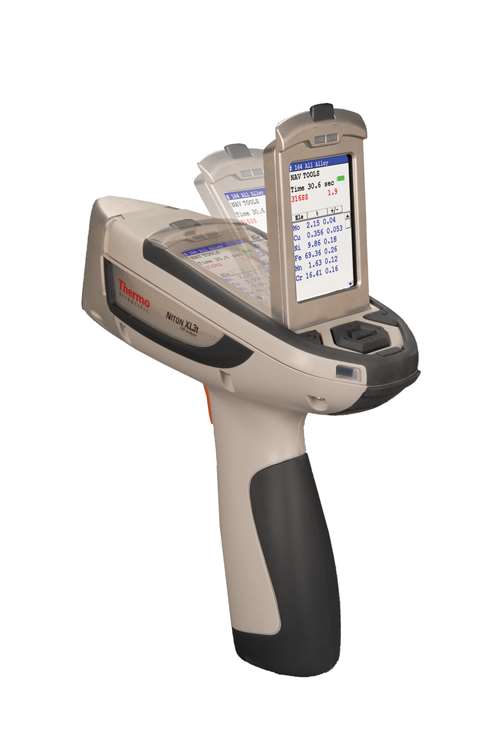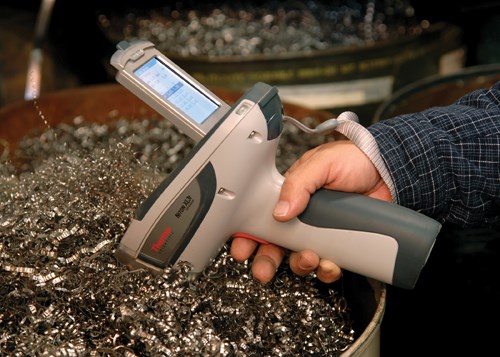Material Analysis At The Source
Growing material costs and quality control concerns have increased demand for accurate and fast methods of analyzing alloy composition. X-ray fluorescence (XRF) handheld analyzers allow in-line testing of a variety of materials.
#workforcedevelopment
Increased costs of metal coating materials have driven the need for improved process control. According to Mark Lessard, Thermo Fisher Scientific’s business development manager for alloy and coatings for the Niton Analyzers business unit, companies now care a lot more about how much coating they put on a part because pricing considerations have forced them to be more conservative. “In the past, companies would slap the coating on, only making sure they had enough, instead conserving more on the time involved in application,” he says. “Now they take time to be more precise. Anything other than the optimum coating thickness is unacceptable either from a quality control or cost control standpoint.”
Beyond cost control and material savings, the necessity of simply delivering products of the correct alloy is a point of significant consideration. Placing an order for materials to match a customer’s spec is one thing; depending on the supplier to deliver what was requested and keeping it organized on the shop floor, especially after stock is cut to length, can be another. But having a firm grasp of the make-up of the materials in stock can easily be the difference between a successful run and hundreds of thousands of wasted parts.
Featured Content
Thermo Fisher Scientific offers a line of X-ray fluorescence (XRF) handheld analyzers that provide general metal finishers and others the advantage of in-line testing, eliminating the need to cut samples and spend valuable time taking the sample to a benchtop analyzer to wait for results. The company’s latest model, the Thermo Scientific Niton XL3t analyzer features the ability to quantify a coating thickness or weight. Mr. Lessard explains, “These portable X-ray units have long had the ability to do alloy identification and chemical composition and concentration with pretty much any type of metal. Now, if you take that same piece of metal and have it coated, we can analyze the thickness and composition of those coating layers.” Each analysis is stored within the analyzer instrument and can be viewed via an environmentally sealed color touchscreen display. Data can be downloaded to a PC or networked storage device via a wireless Bluetooth connection or USB or serial communications.
Simply put, X-ray fluorescence requires two major components. The first is something to generate the X-ray, such as a radioactive isotope or, as in the case of the analyzer, an X-ray tube. The X-rays are sent into the sample and they fluoresce, or reflect off. The reflected rays come back and are collected in the other major component—the detector. The analyzer determines what element is being read based on the energy of the fluoresced X-ray. The quantity of the fluoresced X-ray directly relates to the quantity of the element.
The Niton XL3 analyzer provides nondestructive multilayer coating analysis results in seconds for a variety of part sizes and types, including large or irregularly shaped samples and small-diameter wiring or tubing. Mr. Lessard says, “We’re excited about what this product brings to the industry. In addition to positive grade identification and composition analysis of alloy/metal coatings and substrates, the coating thickness and coating weight measurement capabilities make the instrument an out-of-the-box nondestructive solution for gaging the effectiveness of coating and plating systems.” The device is a natural fit for applications both large and small as samples can be tested without moving them to another location such as a benchtop analyzer.
“The automotive industry is under a lot of pressure right now to improve gas mileage for vehicles,” Mr. Lessard explains as he provides an example application for the analyzer. “Of course, racing teams also strive for better mileage for a competitive advantage. One of the easiest ways to improve mileage is to make a vehicle lighter. Manufacturers are using alloys such as aluminum and adding high-performance coatings to make it more robust for additional strength and corrosion resistance. This strategy is being used for various parts, including piston rings, cylinders and valves. The final result is an inexpensive, lightweight metal that performs much better.”
The analyzer incorporates 80 MHz real-time digital signal processing and dual embedded processors for computation, data storage, communication and other functions. It can also be equipped with a small-spot focus and integrated visualization technology to allow switching between full-area analysis for large samples and a 3-mm small-spot area. An optional internal camera records a digital image of the test area with each sample analysis for documentation.
Whether the need is quality control, sorting of scrap material or even failure analysis, verification of metal alloy grade and composition is crucial to the success of many businesses. Handheld Niton XL3 analyzers provide users with real-time, on-site results with instruments that eliminate delays while providing similar features to benchtop XRF systems. This instrument’s flexibility provides a boost to throughput as it allows uninterrupted processing of workpieces, from incoming stock to outgoing finished parts, at any point in the process.
RELATED CONTENT
-
Metalworking Vacuum Cleaners: One Type Does Not Fit All
As the metalworking industry becomes more specialized, so does the equipment that cleans it. But as diverse as the industry is, it should come as no surprise that there is no single vacuum that can handle all of its requirements.
-
Using Advanced CNC Technology to Overcome Labor Shortages
Many technology innovations in CNC machine tools can ease the burden of the skills gap, including the CNC lathes and multi-spindle machines from INDEX.
-
New Line of Swiss-Types for Job Shops Eyeing High-Production Work
Mazak now offers the Syncrex line of Swiss-type CNC lathes — its first — targeting machine shops getting into higher volume production of complex parts.








